Do you have a question about the Trane SXHJ090-162 and is the answer not in the manual?
Covers important warnings regarding field wiring, grounding, PPE, and environmental concerns.
Details the changes and updates in the current manual version.
Covers checks for shipping damage, material shortages, and location clearances.
Guidelines for storing the unit to prevent condensate formation and damage.
Details on unit nameplate, acronyms, unit description, and control module functions.
Details on Rooftop Module (RTM), Compressor Module (MCM), Human Interface Module (HI), etc.
Descriptions of MPM, MDM, and VCM modules and their functionalities.
Describes CV/VAV unit inputs like sensors (Supply Air, Return Air, Evaporator Temp) and switches (Filter Switch).
Details on controls like Low Pressure Control, Head Pressure Control, Lead-Lag, and sensors like Freezestat.
Information on Humidity, Pressure, and Temperature sensors, and Space Pressure Transducer.
Details on Supply Air Temp Low Limit, Freezestat, Compressor Breakers, and CV unit operations.
Explains VAV operations like Occupied Heating, Daytime Warm-up, and Duct Static Pressure Control.
Explains the role and function of various unit control modules.
Details SZVAV operations including Supply Fan Control, VFD Control, Ventilation, and Space Pressure Control.
Explains SZVAV operations like Occupied Cooling, Economizer, Heating, and DX Cooling sequences.
Specifies minimum operating and service clearances for unit installations.
Guidance on staggering units and cooling tower placement relative to intakes.
Diagram illustrating unit dimensions and key measurement points.
Table detailing dimensions for one-piece air-cooled units without ERW.
Table detailing dimensions for two-piece air-cooled units without ERW.
Table detailing dimensions for two-piece air-cooled units with ERW.
Table detailing dimensions for two-piece air-cooled units, continued.
Table detailing dimensions for two-piece evaporative condenser units.
Table detailing dimensions for two-piece evaporative condenser units, continued.
Table detailing dimensions for two-piece evaporative condenser units, continued.
Table detailing dimensions for three-piece air-cooled units.
Table detailing dimensions for three-piece air-cooled units, continued.
Table detailing dimensions for three-piece air-cooled units, continued.
Table detailing dimensions for three-piece evaporative condenser units.
Table detailing dimensions for three-piece evaporative condenser units, continued.
Table detailing downflow/horizontal airflow configuration dimensions.
Table detailing downflow/horizontal airflow configuration dimensions, continued.
Table detailing downflow/horizontal airflow configuration dimensions, continued.
Table detailing downflow/horizontal airflow configuration dimensions, continued.
Diagram showing water connection locations for evaporative condensers.
Diagram illustrating electrical entry details and locations.
Table showing approximate operating weights for various unit types and tonnages.
Table detailing weight of individual unit components by tonnage.
Table detailing weight of individual unit components, continued.
Table detailing weight of individual unit components, continued.
Table showing roof curb weights for air-cooled and evaporative condensing units.
Guidance on installing roof curbs and connecting ductwork.
Information on locating and installing pitch pockets for power supply entries.
Table providing pitch pocket dimensions in inches.
Diagram illustrating ductwork conversion methods.
Steps for converting horizontal ductwork from right to left side.
Diagrams illustrating ductwork conversion details.
Safety warnings and procedures for rigging and lifting heavy unit components.
Illustrations and guidelines for rigging one-piece units with three lifting lugs.
Illustrations for rigging one-piece units with four lifting lugs.
Illustrations for rigging two-piece units with two lifting lugs.
Illustrations for rigging two-piece units with three lifting lugs.
Instructions for connecting refrigerant tubing for one-piece and multi-piece air-cooled units.
Steps for connecting tubing for evaporative condenser units.
Steps for connecting electric heat power and control wires.
General guidelines for connecting power and control wiring.
Steps for setting the unit on the curb, checking for levelness, and connecting drains.
Verification of power supply compliance, grounding, and wiring connections.
Guidelines for completing field wiring for CV, SZVAV, and VAV controls.
Details requirements for Electric, Gas, Hot Water, and Steam heating installations.
Details on condensate drain connections, including traps and slope.
Procedures for removing compressor assembly, supply/exhaust fan, and evaporative condenser fan shipping hardware.
Steps for installing the Outside Air sensor and pneumatic tubing.
Instructions for connecting gas supply lines and related safety precautions.
Steps for completing gas supply line installation and leak testing.
Details on installing hot water coils, valves, and piping configurations.
Details on installing steam coils, valves, and piping configurations.
Operation and safety information for the external disconnect switch.
Calculations for MCA, MOP, and RDE for cooling and gas heat applications.
Calculations for MCA, MOP, and RDE for electric heat applications.
Guidelines for wiring 24 VAC control devices.
Guidelines for wiring DC analog input/output devices.
Details on remote panels and sensors for constant volume systems.
Information on VAV system controls, including changeover contacts and remote interfaces.
Describes five predefined Emergency Override sequences for unit operation.
Details on VOM operation, customization, and default sequences.
Describes the GBAS module for non-Trane building control system integration.
Covers general checks, rigging, electrical, heating types, and evaporative condenser checks.
Details checks for Electric Heat, Gas Heat, Hot Water, Steam, O/A Sensor, Electrical, and Evaporative Condenser.
Checks for ERW rotation, segment engagement, and seal adjustment.
Details the operational sequence for cooling, including stages and fan speeds.
Describes compressor operation at low ambient temperatures and bypass features.
Describes startup and operation for evaporative condensers including sump fill and freeze protection.
Procedure for setting the drain valve for 'drain' or 'hold' during power loss.
Procedure for setting the drain valve duration timer for the conductivity controller.
Steps to calibrate the conductivity controller for water treatment.
Detailed steps for calibrating the conductivity controller using a thermometer and known rating.
Instructions for setting purge setpoints on the conductivity controller.
Details on modulating dehumidification, including setpoints and override conditions.
Details conditions that disable dehumidification for VAV, SZVAV, and CV units based on temp/humidity.
Explains how the ERW operates in cooling and heating modes, including frost avoidance.
Describes standard two-stage gas furnace operation and Honeywell ignition system.
Explains the sequence of operation for modulating gas heating.
Explains the sequence of operation for electric heat systems.
Details sequences for Electric Heat, SZVAV Heating, DCV, TRAQ, Return Fan, Unit Clustering, Low Charge Protection.
Describes operation for wet heat systems including steam and hot water.
Checklist for final unit startup procedures and readiness.
Information on voltage supply requirements and phase voltage imbalance calculations.
Procedures for compressor startup, charging, and operational sounds.
Steps to verify correct rotation direction for supply, exhaust, and condenser fans.
Procedures for measuring airflow and static pressure in CV systems.
Procedures for measuring airflow and static pressure in VAV systems.
Procedure for measuring exhaust airflow.
Procedure for measuring airflow using the TRAQ™ sensor with an economizer.
Provides performance curves for supply fans with and without VFDs.
Table detailing static pressure drops across various unit components.
Table detailing static pressure drops across various unit components, continued.
Table detailing static pressure drops across various unit components, continued.
Table detailing static pressure drops across various unit components, continued.
Table showing static pressure drops for low CFM ERW units.
Table showing static pressure drops for ERW units, continued.
Table showing static pressure drops for ERW units, continued.
Table showing static pressure drops for ERW units, continued.
Operating pressure curves for 90-ton standard and high capacity air-cooled condensers.
Operating pressure curves for 105-ton standard and high capacity air-cooled condensers.
Operating pressure curves for 120-ton standard and high capacity air-cooled condensers.
Operating pressure curves for 130-ton standard and high capacity air-cooled condensers.
Operating pressure curves for 150-ton standard air-cooled condensers.
Operating pressure curves for 90-ton standard capacity 50Hz air-cooled condensers.
Operating pressure curves for 90-ton high capacity 50Hz air-cooled condensers.
Operating pressure curves for 105-ton standard capacity 50Hz air-cooled condensers.
Operating pressure curves for 105-ton high capacity 50Hz air-cooled condensers.
Operating pressure curves for 120-ton standard capacity 50Hz air-cooled condensers.
Operating pressure curves for 120-ton high capacity 50Hz air-cooled condensers.
Operating pressure curves for 130-ton standard capacity 50Hz air-cooled condensers.
Operating pressure curves for 130-ton high capacity 50Hz air-cooled condensers.
Operating pressure curves for 150-ton standard capacity 50Hz air-cooled condensers.
Details on economizer, exhaust, and OA/RA dampers for standard units.
Explains damper linkage, operation, and adjustment procedures.
Diagrams illustrating outside air and return air damper assembly.
Diagram illustrating the economizer assembly with TRAQ™ dampers.
Table showing damper travel adjustment and pressure drop data.
Step-by-step instructions for adjusting Outside Air and Return Air damper actuators.
Table showing plenum pressure data for ERW units.
Table showing plenum pressure data for ERW units, continued.
Table showing plenum pressure data for ERW units, continued.
Details ERW operation and highlights safety warnings for Toxic Hazards, Motor Failure, Confined Spaces, and Hazardous Voltage.
Steps for ERW startup, including wheel rotation and damper actuator checks.
Procedure for cleaning ERW segments and addressing potential damage.
Steps for removing ERW segments, including safety warnings for voltage and rotating components.
Procedure for removing and replacing inner ERW segments, including safety precautions.
Procedure for removing and replacing outer or satellite ERW segments.
Information on filter types and maintenance for ERW units.
Procedure for replacing the urethane stretch drive belt.
Steps for installing the link belt for the energy wheel.
Procedure for adjusting the seals on the energy wheel.
Procedure for replacing the drive motor and pulley for the energy wheel.
Procedures for compressor startup, charging, and operational sounds.
Guidance on inspecting compressor oil for abnormal conditions.
Description of typical operational sounds from scroll compressors.
Startup procedures for evaporative condensers, including water treatment and shipping bracket removal.
Information on TXV adjustment, superheat measurement, and subcooling.
Minimum starting temperatures for standard ambient units.
Startup procedures for electric, steam, and hot water heating systems.
Procedure for starting up gas furnaces, including air/fuel mixture adjustments.
Steps for adjusting high-fire settings, manifold pressure, and CO2 levels.
Steps for adjusting low-fire settings for 850 & 1100 MBH furnaces.
Procedure for adjusting combustion air for optimal oxygen levels.
Details on modulating gas furnaces including heat exchanger and unit control.
Checklist for final unit startup procedures and readiness.
Trane's review of multi-piece unit installation, utilities, refrigeration, and wiring.
Covers general checks, rigging, electrical, heating types, and evaporative condenser checks.
Details checks for HW/Steam heat, unit startup, fan operation, dampers, evaporative condenser, and operating log.
Table detailing control settings and time delays for various unit functions.
Table specifying high limit settings for various gas heat configurations.
Table specifying selection limits for electric heat options.
Table specifying selection limits for electric heat options, continued.
Table detailing electrical characteristics for compressor circuit breakers.
Table for unit internal fuse replacement and VFD factory settings.
Table providing filter dimensions and quantities for various unit models.
Table providing final filter dimensions and quantities for various unit models.
Procedure for inspecting and adjusting fan belts for proper tension and tracking.
Table listing recommended greases for fan bearings.
Table detailing coil fin configuration, tube diameter, and fin density.
Procedure for replacing scroll compressors, including oil requirements and evacuation.
Instructions for verifying and programming VFD parameters.
Covers VFD programming, monthly maintenance for cooling/filters, and heating season checks.
Instructions for inspecting, cleaning, or replacing unit filters.
Inspects filters, supply fan bearings, heat exchanger, and combustion air blower.
Instructions for cleaning Air-Cooled, Refrigerant, Steam/Hot Water, and Evaporative Condenser coils.
Details on water supply, drain, operation, and care for evaporative condenser sumps.
Information on repairing or replacing microchannel condenser coils.
Instructions for recording unit data in the provided blanks.
Covers important warnings regarding field wiring, grounding, PPE, and environmental concerns.
Details the changes and updates in the current manual version.
Covers checks for shipping damage, material shortages, and location clearances.
Guidelines for storing the unit to prevent condensate formation and damage.
Details on unit nameplate, acronyms, unit description, and control module functions.
Details on Rooftop Module (RTM), Compressor Module (MCM), Human Interface Module (HI), etc.
Descriptions of MPM, MDM, and VCM modules and their functionalities.
Describes CV/VAV unit inputs like sensors (Supply Air, Return Air, Evaporator Temp) and switches (Filter Switch).
Details on controls like Low Pressure Control, Head Pressure Control, Lead-Lag, and sensors like Freezestat.
Information on Humidity, Pressure, and Temperature sensors, and Space Pressure Transducer.
Details on Supply Air Temp Low Limit, Freezestat, Compressor Breakers, and CV unit operations.
Explains VAV operations like Occupied Heating, Daytime Warm-up, and Duct Static Pressure Control.
Explains the role and function of various unit control modules.
Details SZVAV operations including Supply Fan Control, VFD Control, Ventilation, and Space Pressure Control.
Explains SZVAV operations like Occupied Cooling, Economizer, Heating, and DX Cooling sequences.
Specifies minimum operating and service clearances for unit installations.
Guidance on staggering units and cooling tower placement relative to intakes.
Diagram illustrating unit dimensions and key measurement points.
Table detailing dimensions for one-piece air-cooled units without ERW.
Table detailing dimensions for two-piece air-cooled units without ERW.
Table detailing dimensions for two-piece air-cooled units with ERW.
Table detailing dimensions for two-piece air-cooled units, continued.
Table detailing dimensions for two-piece evaporative condenser units.
Table detailing dimensions for two-piece evaporative condenser units, continued.
Table detailing dimensions for two-piece evaporative condenser units, continued.
Table detailing dimensions for three-piece air-cooled units.
Table detailing dimensions for three-piece air-cooled units, continued.
Table detailing dimensions for three-piece air-cooled units, continued.
Table detailing dimensions for three-piece evaporative condenser units.
Table detailing dimensions for three-piece evaporative condenser units, continued.
Table detailing downflow/horizontal airflow configuration dimensions.
Table detailing downflow/horizontal airflow configuration dimensions, continued.
Table detailing downflow/horizontal airflow configuration dimensions, continued.
Table detailing downflow/horizontal airflow configuration dimensions, continued.
Diagram showing water connection locations for evaporative condensers.
Diagram illustrating electrical entry details and locations.
Table showing approximate operating weights for various unit types and tonnages.
Table detailing weight of individual unit components by tonnage.
Table detailing weight of individual unit components, continued.
Table detailing weight of individual unit components, continued.
Table showing roof curb weights for air-cooled and evaporative condensing units.
Guidance on installing roof curbs and connecting ductwork.
Information on locating and installing pitch pockets for power supply entries.
Table providing pitch pocket dimensions in inches.
Diagram illustrating ductwork conversion methods.
Steps for converting horizontal ductwork from right to left side.
Diagrams illustrating ductwork conversion details.
Safety warnings and procedures for rigging and lifting heavy unit components.
Illustrations and guidelines for rigging one-piece units with three lifting lugs.
Illustrations for rigging one-piece units with four lifting lugs.
Illustrations for rigging two-piece units with two lifting lugs.
Illustrations for rigging two-piece units with three lifting lugs.
Instructions for connecting refrigerant tubing for one-piece and multi-piece air-cooled units.
Steps for connecting tubing for evaporative condenser units.
Steps for connecting electric heat power and control wires.
General guidelines for connecting power and control wiring.
Steps for setting the unit on the curb, checking for levelness, and connecting drains.
Verification of power supply compliance, grounding, and wiring connections.
Guidelines for completing field wiring for CV, SZVAV, and VAV controls.
Details requirements for Electric, Gas, Hot Water, and Steam heating installations.
Details on condensate drain connections, including traps and slope.
Procedures for removing compressor assembly, supply/exhaust fan, and evaporative condenser fan shipping hardware.
Steps for installing the Outside Air sensor and pneumatic tubing.
Instructions for connecting gas supply lines and related safety precautions.
Steps for completing gas supply line installation and leak testing.
Details on installing hot water coils, valves, and piping configurations.
Details on installing steam coils, valves, and piping configurations.
Operation and safety information for the external disconnect switch.
Calculations for MCA, MOP, and RDE for cooling and gas heat applications.
Calculations for MCA, MOP, and RDE for electric heat applications.
Guidelines for wiring 24 VAC control devices.
Guidelines for wiring DC analog input/output devices.
Details on remote panels and sensors for constant volume systems.
Information on VAV system controls, including changeover contacts and remote interfaces.
Describes five predefined Emergency Override sequences for unit operation.
Details on VOM operation, customization, and default sequences.
Describes the GBAS module for non-Trane building control system integration.
Covers general checks, rigging, electrical, heating types, and evaporative condenser checks.
Details checks for Electric Heat, Gas Heat, Hot Water, Steam, O/A Sensor, Electrical, and Evaporative Condenser.
Checks for ERW rotation, segment engagement, and seal adjustment.
Details the operational sequence for cooling, including stages and fan speeds.
Describes compressor operation at low ambient temperatures and bypass features.
Describes startup and operation for evaporative condensers including sump fill and freeze protection.
Procedure for setting the drain valve for 'drain' or 'hold' during power loss.
Procedure for setting the drain valve duration timer for the conductivity controller.
Steps to calibrate the conductivity controller for water treatment.
Detailed steps for calibrating the conductivity controller using a thermometer and known rating.
Instructions for setting purge setpoints on the conductivity controller.
Details on modulating dehumidification, including setpoints and override conditions.
Details conditions that disable dehumidification for VAV, SZVAV, and CV units based on temp/humidity.
Explains how the ERW operates in cooling and heating modes, including frost avoidance.
Describes standard two-stage gas furnace operation and Honeywell ignition system.
Explains the sequence of operation for modulating gas heating.
Explains the sequence of operation for electric heat systems.
Details sequences for Electric Heat, SZVAV Heating, DCV, TRAQ, Return Fan, Unit Clustering, Low Charge Protection.
Describes operation for wet heat systems including steam and hot water.
Checklist for final unit startup procedures and readiness.
Information on voltage supply requirements and phase voltage imbalance calculations.
Procedures for compressor startup, charging, and operational sounds.
Steps to verify correct rotation direction for supply, exhaust, and condenser fans.
Procedures for measuring airflow and static pressure in CV systems.
Procedures for measuring airflow and static pressure in VAV systems.
Procedure for measuring exhaust airflow.
Procedure for measuring airflow using the TRAQ™ sensor with an economizer.
Provides performance curves for supply fans with and without VFDs.
Table detailing static pressure drops across various unit components.
Table detailing static pressure drops across various unit components, continued.
Table detailing static pressure drops across various unit components, continued.
Table detailing static pressure drops across various unit components, continued.
Table showing static pressure drops for low CFM ERW units.
Table showing static pressure drops for ERW units, continued.
Table showing static pressure drops for ERW units, continued.
Table showing static pressure drops for ERW units, continued.
Operating pressure curves for 90-ton standard and high capacity air-cooled condensers.
Operating pressure curves for 105-ton standard and high capacity air-cooled condensers.
Operating pressure curves for 120-ton standard and high capacity air-cooled condensers.
Operating pressure curves for 130-ton standard and high capacity air-cooled condensers.
Operating pressure curves for 150-ton standard air-cooled condensers.
Operating pressure curves for 90-ton standard capacity 50Hz air-cooled condensers.
Operating pressure curves for 90-ton high capacity 50Hz air-cooled condensers.
Operating pressure curves for 105-ton standard capacity 50Hz air-cooled condensers.
Operating pressure curves for 105-ton high capacity 50Hz air-cooled condensers.
Operating pressure curves for 120-ton standard capacity 50Hz air-cooled condensers.
Operating pressure curves for 120-ton high capacity 50Hz air-cooled condensers.
Operating pressure curves for 130-ton standard capacity 50Hz air-cooled condensers.
Operating pressure curves for 130-ton high capacity 50Hz air-cooled condensers.
Operating pressure curves for 150-ton standard capacity 50Hz air-cooled condensers.
Details on economizer, exhaust, and OA/RA dampers for standard units.
Explains damper linkage, operation, and adjustment procedures.
Diagrams illustrating outside air and return air damper assembly.
Diagram illustrating the economizer assembly with TRAQ™ dampers.
Table showing damper travel adjustment and pressure drop data.
Step-by-step instructions for adjusting Outside Air and Return Air damper actuators.
Table showing plenum pressure data for ERW units.
Table showing plenum pressure data for ERW units, continued.
Table showing plenum pressure data for ERW units, continued.
Details ERW operation and highlights safety warnings for Toxic Hazards, Motor Failure, Confined Spaces, and Hazardous Voltage.
Steps for ERW startup, including wheel rotation and damper actuator checks.
Procedure for cleaning ERW segments and addressing potential damage.
Steps for removing ERW segments, including safety warnings for voltage and rotating components.
Procedure for removing and replacing inner ERW segments, including safety precautions.
Procedure for removing and replacing outer or satellite ERW segments.
Information on filter types and maintenance for ERW units.
Procedure for replacing the urethane stretch drive belt.
Steps for installing the link belt for the energy wheel.
Procedure for adjusting the seals on the energy wheel.
Procedure for replacing the drive motor and pulley for the energy wheel.
Procedures for compressor startup, charging, and operational sounds.
Guidance on inspecting compressor oil for abnormal conditions.
Description of typical operational sounds from scroll compressors.
Startup procedures for evaporative condensers, including water treatment and shipping bracket removal.
Information on TXV adjustment, superheat measurement, and subcooling.
Minimum starting temperatures for standard ambient units.
Startup procedures for electric, steam, and hot water heating systems.
Procedure for starting up gas furnaces, including air/fuel mixture adjustments.
Steps for adjusting high-fire settings, manifold pressure, and CO2 levels.
Steps for adjusting low-fire settings for 850 & 1100 MBH furnaces.
Procedure for adjusting combustion air for optimal oxygen levels.
Details on modulating gas furnaces including heat exchanger and unit control.
Checklist for final unit startup procedures and readiness.
Trane's review of multi-piece unit installation, utilities, refrigeration, and wiring.
Covers general checks, rigging, electrical, heating types, and evaporative condenser checks.
Details checks for HW/Steam heat, unit startup, fan operation, dampers, evaporative condenser, and operating log.
Table detailing control settings and time delays for various unit functions.
Table specifying high limit settings for various gas heat configurations.
Table specifying selection limits for electric heat options.
Table specifying selection limits for electric heat options, continued.
Table detailing electrical characteristics for compressor circuit breakers.
Table for unit internal fuse replacement and VFD factory settings.
Table providing filter dimensions and quantities for various unit models.
Table providing final filter dimensions and quantities for various unit models.
Procedure for inspecting and adjusting fan belts for proper tension and tracking.
Table listing recommended greases for fan bearings.
Table detailing coil fin configuration, tube diameter, and fin density.
Procedure for replacing scroll compressors, including oil requirements and evacuation.
Instructions for verifying and programming VFD parameters.
Covers VFD programming, monthly maintenance for cooling/filters, and heating season checks.
Instructions for inspecting, cleaning, or replacing unit filters.
Inspects filters, supply fan bearings, heat exchanger, and combustion air blower.
Instructions for cleaning Air-Cooled, Refrigerant, Steam/Hot Water, and Evaporative Condenser coils.
Details on water supply, drain, operation, and care for evaporative condenser sumps.
Information on repairing or replacing microchannel condenser coils.
Instructions for recording unit data in the provided blanks.
| Brand | Trane |
|---|---|
| Model | SXHJ090-162 |
| Category | Air Conditioner |
| Language | English |


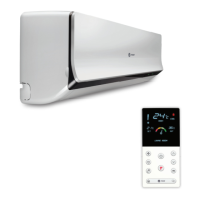

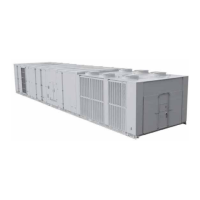

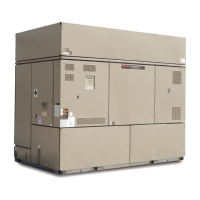
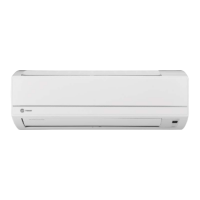
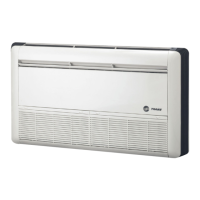


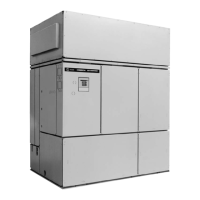
